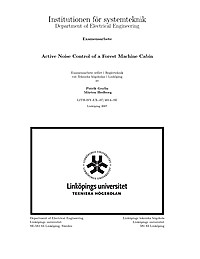
Active Noise Control of a Forest Machine Cabin
Today, a high noise level is considered a problem in many working environments. The main reason is that it contributes to stress and fatigue. Traditional methods using passive noise control is only practicable for high frequencies. As a complement to passive noise control, active noise control (ANC) can be used to reduce low frequency noise. The main idea of ANC is to use destructive interference of waves to cancel disturbing noises. The purpose of this thesis is to design and implement an ANC system in the driver's cabin of a Valmet 890 forest machine. The engine boom is one of the most disturbing noises and therefore the main subjective for the ANC system to suppress. The ANC system is implemented on a Texas Instrument DSP development starter kit. Different FxLMS algorithms are evaluated with feedback and feedforward configurations. The results indicate that an ANC system significantly reduces the sound pressure level (SPL) in the cabin. Best performance of the evaluated systems is achieved for the feedforward FxLMS system. For a commonly used engine speed of 1500 rpm, the SPL is reduced with 17 dB. The results show fast enough convergence and global suppression of low frequency noise.


















